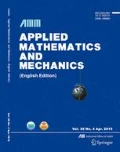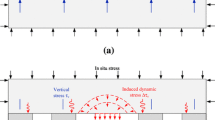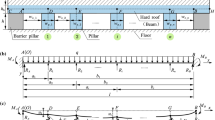Abstract
A simplified mechanical model of pillar-hang wall was established in asymmetric mining and instability of the system was discussed by means of potential energy principle and cusp catastrophe theory. The necessary-sufficient condition and the jump value of displacement of pillar and the released energy expressions were derived, which established foundation for quantifying of the instability of system. The results show that instability of the system is related to load and its stiffness distribution. The critical load increases with the increasing relative stiffness, and the system is more stable. On the contrary, the instability of system is likely to occur, and the released energy is larger in instability process, and the harm is more tremendous accordingly. Furthermore, an example was calculated, and the estimated results are in good agreement with the practical experience, which provide basis for mining order and arranging stope.
Similar content being viewed by others
References
Qin Siqing, He Huaifeng. Analysis on the destabilization for the narrow coal pillar burst by the catastrophe theory[J].Hydrogeology and Engineering Geology, 1995,18(5): 17–20 (in Chinese).
Xu Zenghe, Xu Xiaohe, Tang Chunan. Theoretical analysis of a cusp catastrophe bump of coal pillar under hard rocks[J].Journal of China Coal Society, 1995,20(5): 485–491 (in Chinese).
Xu Zenghe, Xu Xiaohe. Cusp catastrophe of occurrence conditions and hysteresis of rockbursts in pillar workings[J].The Chinese Journal of Nonferrous Metals, 1997,7(2): 17–23 (in Chinese).
Li Hong, Xu Zenghe, Xu Xiaohe. Criterions and forewarning of ore pillar rock bursts in asymmetric mining[J].China Mining Magazine, 1997,6(1): 46–51 (in Chinese).
Jeremic M L.Rock Mechanics in Hard Rock Mining[M]. Zhao Yuxue (transl). Metallurgy Press, Beijing, 1990 (Chinese version).
Tang Chunan, Xu Xiaohe. A cusp catastrophe model of rock unstable failure[J].Chinese Journal of Rock Mechanics and Engineering, 1990,9(2): 100–107 (in Chinese).
Saunders P T.An Introduction to Catastrophe Theory[M]. Cambridge University Press, Cambridge, 1980.
Qin S, Jiao J J, Wang S. A cusp catastrophe model of instability of slip-buckling slope[J].International Rock Mechanics and Rock Engineering, 2001,34(2): 119–134.
Pan Yishan, Zhang Mengtao, Li Guozheng. The Study of chamber rockburst by the cuspmodel of catastrophe theory[J].Applied Mathematics and Mechanics (English Edition), 1994,15 (10): 943–951.
Chen Yu.Mechanical Properties of Crust Rocks (Basic Theory and Experimental Techniques) [M]. Seismological Press, Beijing, 1988 (in Chinese).
Author information
Authors and Affiliations
Corresponding author
Additional information
Communicated by Xie He-ping
Project supported by the National Natural Science Foundation of China (No. 50274074)
Rights and permissions
About this article
Cite this article
Jiang-teng, L., Ping, C. Cusp catastrophe model of instability of pillar in asymmetric mining. Appl Math Mech 26, 1100–1106 (2005). https://doi.org/10.1007/BF02466424
Received:
Revised:
Issue Date:
DOI: https://doi.org/10.1007/BF02466424
Key words
- pillar
- stability
- potential energy
- cusp catastrophe
- asymmetric mining
- Chinese Library Classification
- O343.3
- TD324.1




